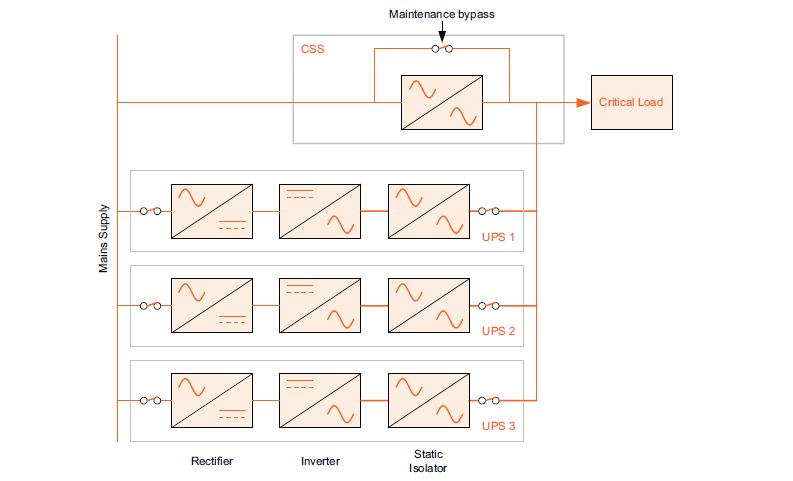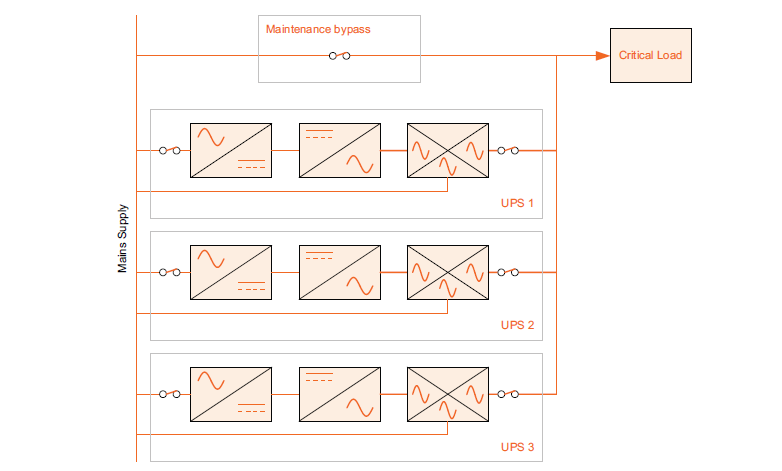Depending on its load capacity, a UPS module may comprise a rack-mountable unit or a larger floor standing installation. Either way, many UPS solutions comprise two or more modules connected in parallel. This can be done to increase either capacity or, more commonly, UPS availability.
UPS systems that are paralleled to increase availability are known as redundancy systems. For full redundancy, decentralised parallel architecture should be used; that is, each module should be capable of operating independently, without reliance on any centralised or common components. In this article, Kenny Green, Technical Support Manager at KOHLER Uninterruptible Power Ltd, a KOHLER company, discusses parallel redundant system optimisation and the benefits of modular UPS design.
If a major organisation suffers a power glitch, it doesn’t take long for the effects to be felt – not only by large numbers of frustrated customers, but also in terms of adverse publicity. When one major bank experienced a power failure early one Saturday afternoon, they claimed to have fixed it within 20 minutes – yet in that period, customers could not use their debit or credit cards for making purchases, withdrawing cash from ATM machines or accessing their online accounts and the incident made the BBC News at the time.
Faced with such scenarios, organisations are highly motivated to invest in the best available uninterruptible power supply (UPS) solutions and to deploy them in a way which maximises their power availability. In this article, we look at why parallel, modular UPS configurations offer the best, most truly effective redundancy solutions.
Parallel redundant systems
A system has redundant capacity that translates into fault resilience if it has more capacity the load actually requires. However, achieving redundancy while efficiently using UPS capacity needs a modular approach. Consider, for example, a load of 120kVA. This could be supported with a traditional, single-unit 120kVA UPS system. For redundancy, though, two such units would be need to be paralleled to supply the load, creating a large system with a total capacity of 240kVA. This means that under normal conditions the UPS is only half-loaded and operates at only 91% efficiency, while capital expenditure has been wasted on capacity that isn’t needed.
Now consider the same 120kVA load being supplied by smaller UPS modules rated at 40kVA each. Three modules can support the load, but redundancy is achieved by adding a fourth to create a total capacity of 160kVA. Each UPS module now has a 75% load and operates at 95.5% efficiency under normal conditions, while excess capacity has been reduced from 120 to 40kVA.
Generically, these parallel redundant systems are said to offer N+1 redundancy, where N is 3 in the above example. If extra security is required, more than one redundant module can be added to create an N+x redundant system. ‘x’ is referred to as the coefficient of redundancy for the system.
Centralised and de-centralised parallel systems
These N+x modular solutions, now widely used in data centres and other critical load environments, can be implemented as either centralised or de-centralised parallel architectures. The first approach offers some financial economies, while the second provides the ultimate in power availability.
Fig.1: Three module centralised UPS system
A ‘centralised’ architecture is so-called because its implementation includes a centralised static switch (CSS) as a shared component, as shown in Fig.1. This saves some money as it eliminates the need for each UPS module to have its own static switch. However, it impairs the overall system’s resilience to failure because it introduces ‘single points of failure’ into the power path. Fig.1 shows the CSS’s role in providing three possible routes to the critical load; from the UPS inverter outputs, from the raw mains via an internal static bypass switch or contactor or from the raw mains via a maintenance bypass switch. The CSS performs central control of all system synchronisation and load transfer functions.
During normal operation all the UPS modules are on line while being synchronised to one another and to the standby mains supply. They share the load current equally. If a module fails, it automatically isolates itself from the system by rapidly opening its output static switch. The healthy modules continue to support the critical load if the remaining system capacity allows, otherwise the load is transferred to the standby mains by the CSS.
A de-centralised system comprises a set of parallel modules feeding the load directly. Each module is entirely autonomous and in fact is usually capable of working in ‘standalone’ mode; no shared components are used, so no single point of failure exists. Fig.2 shows a de-centralised system with three modules. One module acts as Master while the others are Sub-Master. If the Master fails, or is taken off line for maintenance, the next UPS in line will take over, changing from Sub-Master to Master while doing so.
Note also from Fig. 2 that each UPS module has its own static bypass switch, rated for the full load capacity of the module. Each switch performs for its UPS as the CSS does for the overall system in a centralised architecture; it manages three possible power paths to the critical load. During normal operation, all UPSs are online with their inverter output connected through the switch to the critical load. The inverters are all synchronised to one another and to the standby mains supply if present. The UPSs share the load equally.
Fig. 2: De-centralised UPS system with three modules
If a module develops a fault, it automatically isolates itself from the load by inhibiting its connection through the output static switch. The remaining healthy modules continue to support the load if they have sufficient capacity; otherwise all modules’ – including the faulty module’s – static switches will connect the standby mains directly to the load. A break-free transfer is achieved if the system is synchronised; otherwise the healthy modules will supply the critical load for as long as possible before switching off to protect themselves.
Transformerless design, rack-mounting modules and hot swapping
Given that de-centralised parallel systems offer optimal redundancy and power availability, it’s worth remembering the modular topography that makes these systems so economical in both cost and size. Modern UPS modules’ compact, light design allows several to be assembled into a single rack to achieve the required N+1 redundant configuration.
This design is enabled by transformerless technology, which has significantly reduced the size and weight associated with earlier transformer-based designs. For example, a typical 50kVA transformer-based three-phase UPS weighs 400 Kg, whereas its transformerless equivalent could weight as little as 60 Kg. This difference converts the UPS from an immobile floor-based unit to a flexibly deployable rack mounting module.
The appearance of parallel rack mounting modules has also facilitated ‘hot swapping’, which makes a further important contribution to a redundant UPS’s power availability. Hot swapping allows operators to replace a faulty module with a healthy one without interruption of conditioned power to the critical load. MTTR is minimised, significantly improving availability.
Conclusion
In this article we have seen how modern UPS design encompasses parallel redundancy, fully de-centralised architecture, rack-mounting UPS modules and hot swapping to achieve optimum power availability. Guaranteeing this availability remains the UPS’s primary function, and makes UPS systems essential to any sizeable enterprise’s viability today.






